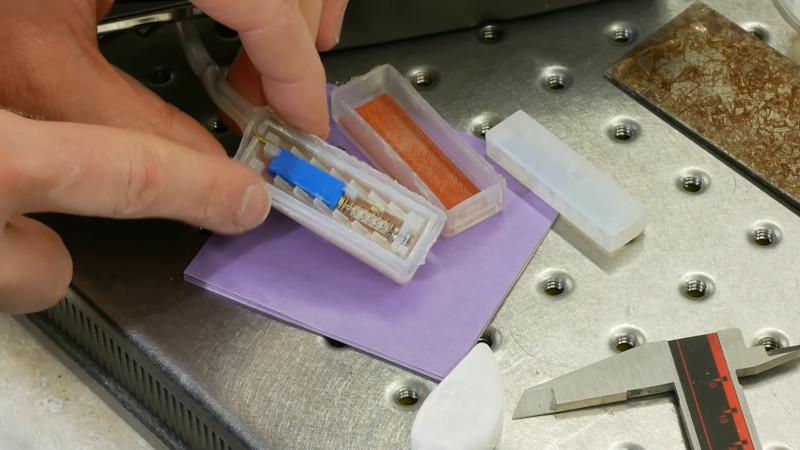Sometimes, standard hardware won’t do when it comes to the differently abled. [Ben Krasnow] found himself recently working on a project for a musician who doesn’t have the use of his legs, and thus needed to create a new interface to replace a standard expression pedal.
[Ben] is a big fan of the build first method of working, and demonstrates why it works well. In this case, the first attempt involved a pneumatic design, where the user would bite down on an air bladder that actuated a remotely-located potentiometer via a tube and bellows. However, while this design worked, the tactile feedback was poor. This led to experimentation with mechanical designs, with an initial attempt involving a 3D printed mechanism and a rotary pot. This was better, but still had problems with damage from teeth and poor feel .The final design is essentially an analog button, built with fabric-impregnated silicone for wear resistance and using a linear pot for smooth feedback.
The final design is impressively tidy, and [Ben] notes that while it looks simple, it was only arrived at by trying plenty of worse solutions first. We’ve seen other work done in the gaming world too; recently, modular controllers have come into vogue to serve a wide variety of needs. Video after the break.
[Thanks to Baldpower for the tip!]
















At first I thought this was about expression pedal as in organ etc.
This problem would be a challenge for a real piano. If I had to do this for someone, I’d go pneumatic like a player piano of old. The new tech has a fist sized silent solenoid to do the dampers. That would require a DC supply and PWM, doable though.
In these modern players though they do not have a variable lift on the dampers. Player rolls are digital too, nor does standard notation have anything but [ped] and the sostenuto pedal and soft are on off as well.
If the dampers are well regulated this is a good effect to express with. I just installed a modern player on a grand. Then I let George Gershwin’s digital self play and I watch and adjust the damper trap to perfection.
I realize this is a prototype and a one-off for a single user so I’m not concerned with the chemical aspects of the design. To be a product, you’d have to go through and use food safe materials and glues and such. Not a problem at this stage.
Having wires go from your mouth to something that plugs into the AC outlet is a problem, even as a prototype. Ben should at least end the wires in a battery operated unit with opto-isolators translating the signal from the mouth to the piano in a safe manner. Given the obiquity of simple bluetooth chips today, I might suggest a small device with a bluetooth chip (battery operated, on the end of the tube outside the user’s mouth) paired with a device on the pot going into the piano. That way there’s no chance of conducting AC into the user’s mouth, even at the prototype stage.
(Not being a safety nanny here, it’s the right way to do this and I’m suggesting solutions instead of carping on how dangerous it is.)
Ben bit through the coating on his previous versions, the end user could accidentally flip the device 90 degrees and bite into the sides by mistake, or something, to get saliva into the electronics and make contact with the big black thing that plugs into the wall.